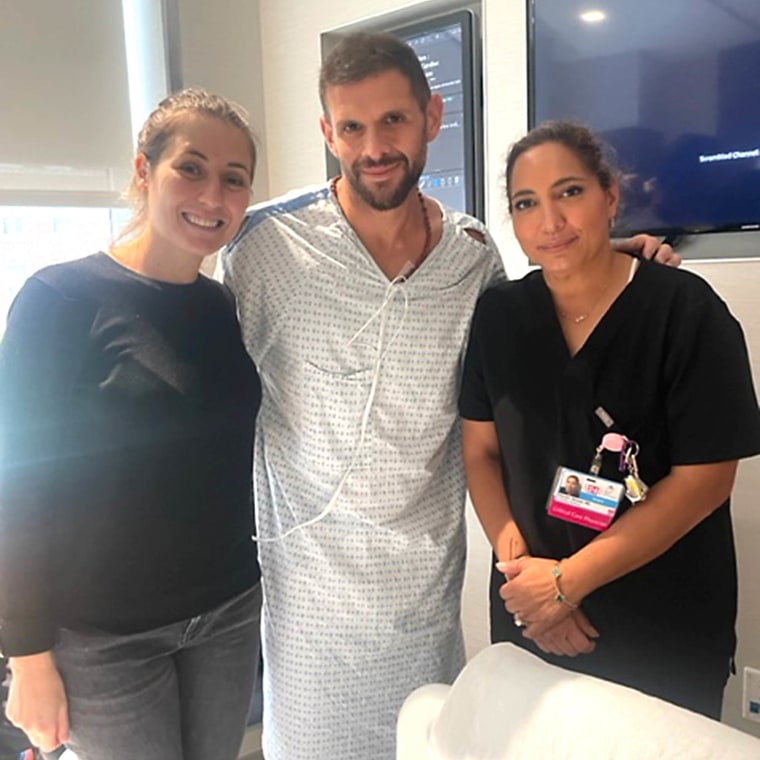Twelve minutes. That’s how long Matias Escobar lay on the ground without a pulse while paramedics performed CPR after his heart stopped last October. Moments earlier, the healthy 38-year-old collapsed from a heart attack while running the final leg of the New York triathlon.
Escobar suffered an ST-segment elevation myocardial infarction (STEMI) – the most deadly type of heart attack. “It’s called the widow maker. … They told me less than 2 percent of people survive,” Escobar told TODAY in an exclusive interview that aired Thursday (May 30).
Against all odds, Escobar survived. After spending several days in the hospital in a coma and having a stent placed in his coronary artery, Escobar made a spectacular recovery. But the near-fatal heart attack left the healthy triathlete and his doctors wondering what happened – and what signs could they have missed?

Escobar was a runner for over two decades and competed in numerous triathlon and Ironman races. At the time of his heart attack in 2023, Escobar described himself as the epitome of health.
The New York resident ate a healthy diet, suffered no stress or anxiety, did not smoke and rarely drank. A pre-race medical examination revealed that he had normal blood pressure and cholesterol levels.
In fact, Escobar presented no obvious risk factors. His heart attack was unexpected and unexplained.
More young people are having heart attacks with fewer warning signs
Doctors say Escobar is part of a growing trend of younger, seemingly healthy adults suffering sudden cardiac events.
“Typically, about 10 to 20 percent of people who come in with a heart attack don’t have any obvious traditional cardiovascular risk factors,” Dr. Deepak Bhatt, director of Mount Sinai Fuster Heart Hospital, said in an interview with TODAY. HU.
Conventional risk factors for a heart attack include high blood pressure, high blood sugar or diabetes, high cholesterol, being overweight or obese and smoking, Bhatt said.
These are also known standard modifiable risk factors, or “SMuRFs,” which account for about 80% of heart attacks, Bhatt explained.
But research has shown that there are a growing number of young, apparently healthy heart attack patients without SMuRF.
Today, Bhatt and a group of doctors at Mount Sinai are following patients like Escobar to determine if there are other risk factors that have been missed or if there are other ways to think about heart attacks.
“There are certainly more young people arriving with a heart attack. There is data to back this up. What’s driving this is the most controversial,” Bhatt said.
One possible reason for the increase in heart attacks without SMuRF is that these classic risk factors are not identified in younger patients. For example, young, healthy people may not have their cholesterol levels or blood pressure checked regularly.
Another possible reason is that doctors don’t consider other behaviors or qualities that might increase heart attack risk because they aren’t traditionally considered risk factors, Bhatt noted.
These include smoking marijuana, using cocaine, and a larger waistline. “It probably has to do with the obesity epidemic, and I hate to say it, but there’s more drug abuse these days,” Bhatt said.
Another potential clue is inflammation, which appears to be a common denominator in many patients without SMuRF.
“What causes most heart attacks is plaque in the artery, and inflammation (can) cause the plaque to react and then it ruptures, which can form a blood clot. … If it’s a big enough clot, it will block the artery,” Bhatt explained.
“Inflammation can be a good thing…If you have an infection, you want to have a fever and you want the inflammation to clear the infection,” he continued. “I’m talking about lower, more latent inflammation, which seems to predispose to heart attack (and) also stroke risk. There are markers that look for that.”
Looking for clues in a patient’s history
At the hospital, Escobar’s doctors dug deeper to see what they might have missed and “to understand why a young man like him, so healthy and athletic, would end up in dire condition,” Dr. Serdar Farhan, an interventional cardiologist at Mount Sinai Hospital and Escobar’s doctor, told TODAY.
In Escobar’s case, he not only had a heart attack, but also the most deadly form. A STEMI causes a complete blockage of the main artery supplying oxygen-rich blood to the heart muscle, according to the Cleveland Clinic. “This (artery) supplies about 60 to 70 percent…That’s why it’s called a widow maker,” Farhan said.
As Escobar described it: “It’s immediate, you don’t have any type of warning, (like) ‘Oh, my arm is starting to hurt, my chest hurts or I feel dizzy ‘ — it’s just sudden. It’s a sudden death.

Upon investigation, doctors discovered that Escobar had signs of inflammation, including elevated C-reactive protein, which is secreted by the liver in response to infections or inflammation. However, it is unclear whether this marker was elevated before his heart attack and for how long; it may have only increased afterward, which happens in some patients, Farhan said.
The cause of inflammation in otherwise healthy patients like Escobar is not yet clear.
Doctors also discovered that the triathlete had high cholesterol levels when he was younger.
“The cardiologist at the time didn’t define this as a risk. It was a data point I had to reduce, but I wasn’t diagnosed with anything,” says Escobar, adding that he was able to reduce his rate cholesterol naturally thanks to your diet.
At the time of his heart attack, his cholesterol levels were normal.
“Was it a risk? Of course, what matters is what your cholesterol level is today, but also how long it was high and how high – this determines how much plaque (you have), even if it has been well controlled,” Bhatt said.
According to the Mayo Clinic, high cholesterol can cause fatty deposits to build up in blood vessels, which break off and cause a clot, leading to a heart attack.
“(They told me) it happens to athletes, if (you have) cholesterol in your veins, no matter how healthy you are,” Escobar noted.
Reduce the risk of heart attacks in young people
Experts say it’s important for patients and doctors to be aware of potential heart attack risk factors and get routine checkups.
“I think that’s the most important message: know the risk factors and know your numbers. Everyone should know their blood sugar, blood pressure, waist size and bad (LDL) cholesterol. This are key vital signs,” Bhatt said.
People can reduce their risk of heart disease by eating a healthy diet rich in fresh fruits, vegetables, whole grains, and limiting red meat. Exercising for at least 30 minutes a day, getting enough sleep and managing stress are also important, Bhatt emphasized.
The Mount Sinai research team is currently working on a project to study trends in patients without SMURF. As doctors become aware of cases like Escobar’s and gather more information, they hope to better understand what are considered “risk factors” in order to save more young lives.
Today, Escobar is recovering well. The husband and father of a 2-year-old follows a vegan diet and stays active. As for his next race, he is already preparing for the New York Triathlon.
“I thought about it a lot. At first I didn’t want to do the same race that killed me, but I think I have to do it,” Escobar says, adding that he won’t let fear stop him .